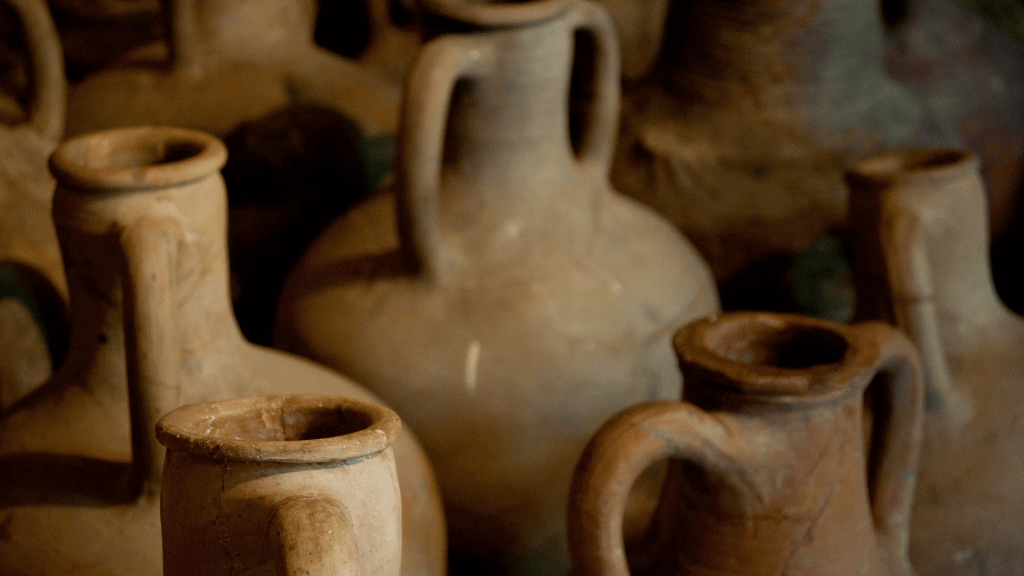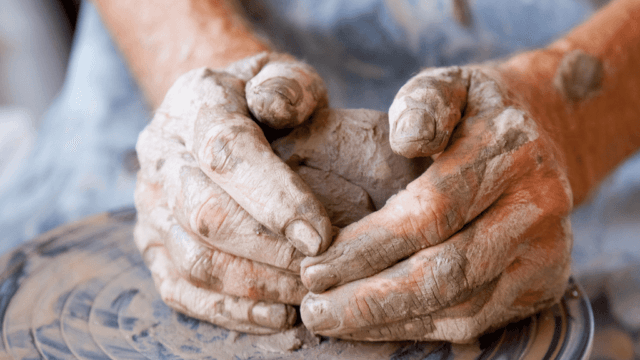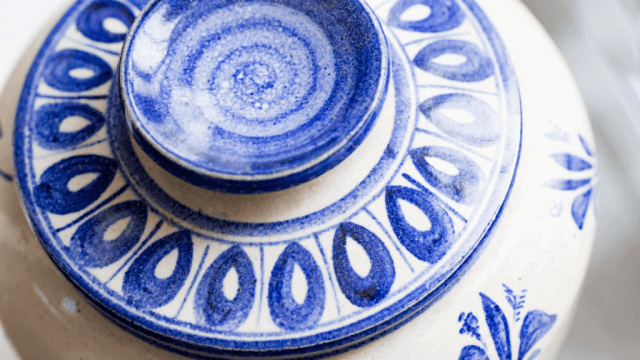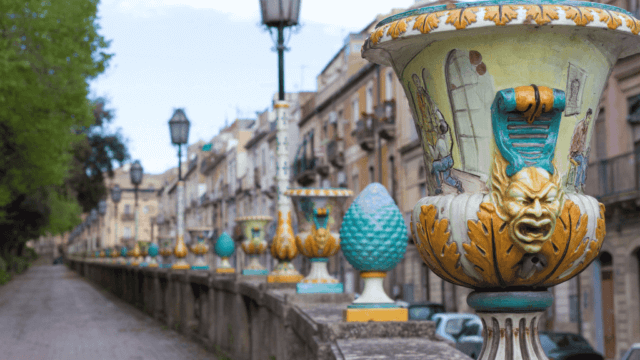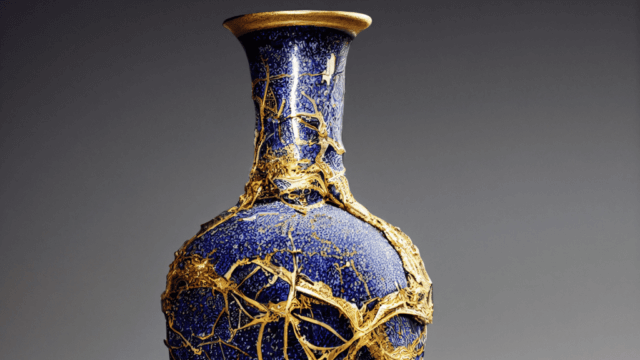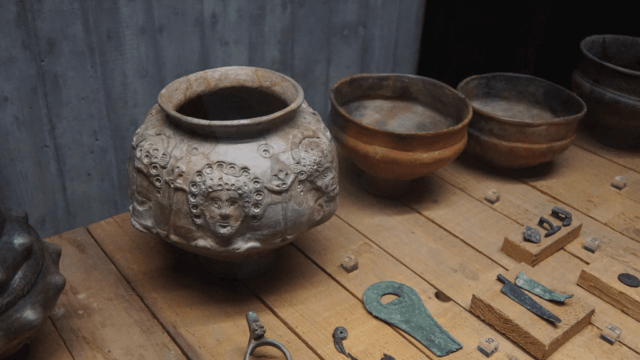Minoan Pottery refers to the distinctively styled ceramics produced by the Minoan civilization on the island of Crete and its surrounding areas during the Bronze Age (circa 3000-1100 BCE).
It is known for its rich decoration, intricate designs, and advanced techniques, which include polychromatic painting and decorative features, like marine-inspired motifs, geometric patterns, and naturalistic representations of plant and animal life.
Origins of Minoan Pottery
The Minoan civilization thrived on the island of Crete and nearby regions during the Bronze Age, from around 3000 to 1100 BCE.
Minoan pottery is renowned for its unique craftsmanship, intricate designs, and advanced techniques that showcase the artistic heritage of this ancient culture.
Techniques and Materials Used in Minoan Pottery
Clay Preparation
Minoan potters carefully selected and prepared their clay from local sources.
After cleaning and filtering, they mixed it with water, sand, or other additives to achieve the desired consistency and workability.
Wheel-Throwing and Shaping
Minoans were among the first to use the potter’s wheel, a technology that allowed them to create uniform, symmetrical vessels.
For larger or more complex forms, they used the coil-building or slab-building methods.
Firing Techniques
After the vessels were shaped and dried, they were fired in specially designed kilns.
The Minoans were skilled in controlling the firing process, which allowed them to produce a wide range of pottery colors and finishes, from glossy, highly polished surfaces to more matte appearances.
Decoration and Motifs in Minoan Pottery
Polychromatic Painting
One of Minoan pottery’s distinguishing features is its vibrant, polychromatic painting.
Potters used mineral-based pigments, such as iron oxide for red, manganese for black, and copper for green, to create elaborate scenes and designs on their vessels.
Marine-inspired Motifs
Being a seafaring culture, Minoan pottery often features marine elements, like dolphins, octopuses, and other aquatic creatures, demonstrating their deep connection to the sea and its importance in their daily lives.
Geometric Patterns and Naturalistic Forms
Geometric shapes, plant life, and animals also adorned Minoan pottery.
Through careful observation and skilled craftsmanship, the Minoans were able to represent intricate details of flowers, leaves, and other organic forms on their ceramics.
Types of Minoan Pottery
Kamares Ware
One of the most famous types of Minoan pottery is Kamares Ware, named after the Kamares cave on Crete where it was first discovered.
This style, popular during the Middle Minoan period (2000-1600 BCE), is known for its curvilinear designs, bright colors, and intricate patterns.
Marine Style
The Marine Style, which emerged in the Late Minoan era (around 1600-1100 BCE), is characterized by its detailed depictions of marine life.
This type of pottery often features a dark background with lighter-colored motifs, creating a striking contrast.
Palace Style
The Palace Style, also from the Late Minoan period, is associated with the elaborate frescoes found in Minoan palaces.
This pottery style often features larger vessels and depicts mythological or religious scenes, showcasing the complexity and refinement of Minoan artistic skill.
Influence of Minoan Pottery on Neighboring Civilizations
Minoan pottery had a significant impact on the artistic endeavors of neighboring civilizations, particularly the Mycenaeans of mainland Greece.
As Minoan culture expanded and engaged in trade with surrounding regions, their pottery techniques and decorative motifs spread and influenced the ceramic production across the Aegean Sea.
Function and Uses of Minoan Pottery
Minoan pottery was created for a variety of purposes, serving both functional and ceremonial needs.
Commonly produced items included plates, cups, storage jars, pitchers, and amphorae for storing and serving food and liquids.
Minoan pottery was also utilized in religious contexts, particularly during rituals and ceremonies, and often found as funerary offerings in tombs.
Actionable Tips for Identifying Minoan Pottery
Shape and Size
The shape and size of a pottery piece can provide clues to its origin.
Minoan pottery shapes typically range from small cups to large storage vessels, with a wide variety of forms.
Pay attention to the overall proportions, including the curvature of the body, the design of the handles, and other design elements.
Design and Motifs
Minoan pottery is recognizable by its unique designs and motifs, such as polychromatic painting, marine-inspired elements, and geometric patterns.
When identifying a Minoan pottery piece, look for the presence of these distinctive features.
Color
Minoan pottery is often far more colorful than pottery from other cultures of the same era.
Look for vivid color combinations, including the use of black and red, which are typical of Minoan polychromatic painting.
FAQs About Minoan Pottery
Below are some frequently asked questions related to Minoan pottery, its origins, and its distinctive characteristics.
This section provides a quick reference for readers looking to learn more about this fascinating art form.
When was Minoan pottery made?
Minoan pottery was produced during the Bronze Age, between approximately 3000 and 1100 BCE.
It was created by the Minoan civilization that inhabited the island of Crete and its surrounding areas.
Why is Minoan pottery significant?
Minoan pottery is considered significant due to its exceptional artistry, advanced techniques, and innovative designs that showcase the Minoan civilization’s rich artistic heritage.
It also influenced the ceramics of neighboring civilizations, such as the Mycenaeans.
What are the typical designs found on Minoan pottery?
Some common designs and motifs found on Minoan pottery include polychromatic painting, marine-inspired elements (e.g., dolphins and octopuses), geometric patterns, and naturalistic depictions of plant and animal life.
What are the main types or styles of Minoan pottery?
Three of the most well-known styles of Minoan pottery are Kamares Ware (from the Middle Minoan period, characterized by curvilinear designs and bright colors), Marine Style (from the Late Minoan period, featuring detailed depictions of marine life), and Palace Style (also from the Late Minoan period, associated with frescoes found in palaces and depicting mythological or religious scenes).
How were Minoan pottery objects used?
Minoan pottery served both functional and ceremonial purposes.
They produced everyday items like plates, cups, storage jars, and pitchers, as well as ceremonial objects used in religious contexts and funerary offerings found in tombs.
